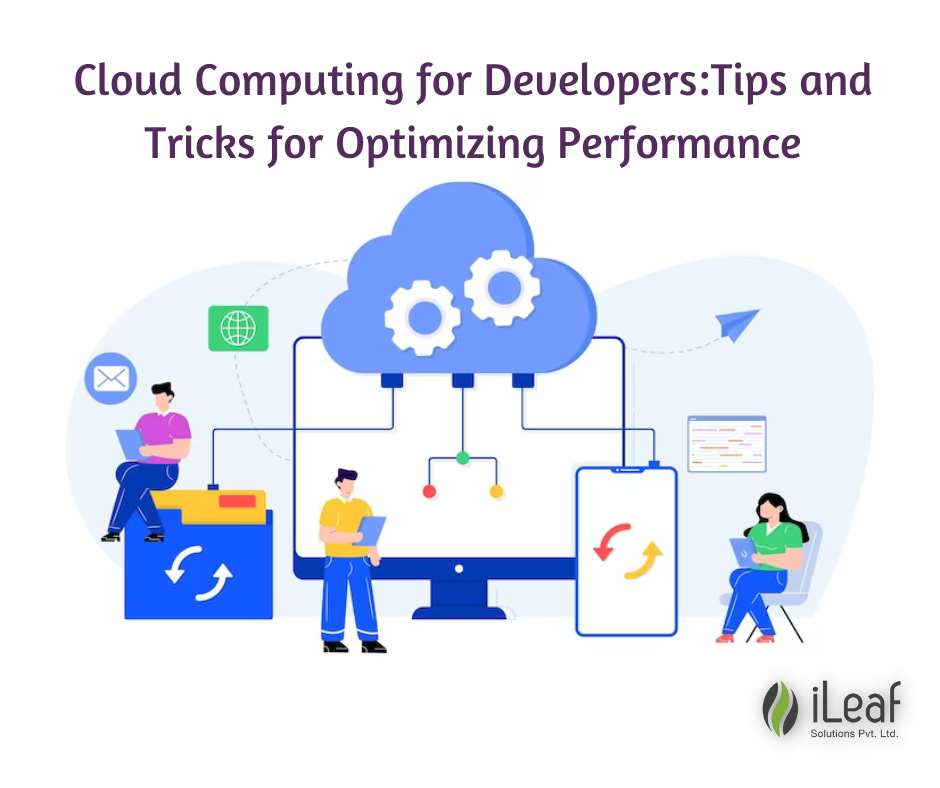Cloud Computing for Developers: Tips and Tricks for Optimizing Performance

The advent of cloud computing has brought about a significant transformation in the way developers create and launch applications, ushering in a new era of flexibility, scalability, and efficiency in the software development process.With the ability to scale resources up or down on demand, developers can now build applications that are highly available, scalable, and fault-tolerant. However, optimizing performance in the cloud can be a challenge. In this blog post, we will discuss some tips and tricks for optimizing performance in cloud computing.
Choose the Right Instance Type
Choosing the right instance type is critical for optimizing performance in the cloud. Instance types vary in terms of CPU, memory, storage, and network performance. For example, if your application requires high CPU performance, you should choose an instance type that has a high number of vCPUs. Similarly, if your application requires high memory performance, you should choose an instance type that has a high amount of memory. Choosing the right instance type can significantly improve the performance of your application.
Use Auto Scaling
Auto Scaling is a feature that allows you to automatically scale your application based on demand. With Auto Scaling, you can set up rules to automatically add or remove instances based on CPU utilization, network traffic, or other metrics. This ensures that your application always has the right amount of resources to handle the current load. Auto Scaling can significantly improve the performance of your application by ensuring that it is always running at optimal capacity.
Use a Content Delivery Network (CDN)
A Content Delivery Network (CDN) is a network of servers that are distributed around the world. When a user requests content from your application, the CDN will serve the content from the server that is closest to the user. This reduces latency and improves the performance of your application. Using a CDN can significantly improve the performance of your application, especially if you have users located in different parts of the world.
Use Caching
Caching is a brilliant strategy enabling the storage of frequently accessed data in memory, boosting efficiency and performance.This reduces the number of requests that your application needs to make to the database, which can significantly improve performance. Unlock the power of caching through various techniques, such as in-memory caching, distributed caching, and content caching, to optimize performance and supercharge your data retrieval capabilities. Choosing the right caching strategy can significantly improve the performance of your application.
Optimize Database Performance
Database performance is critical for the performance of your application. There are several techniques that you can use to optimize database performance, including indexing, partitioning, and sharding. Indexing allows you to quickly search for data in the database, while partitioning and sharding allow you to distribute data across multiple servers. Optimizing database performance can significantly improve the performance of your application.
Use Load Testing
Load testing is a technique that allows you to simulate a large number of users accessing your application at the same time. Load testing can help you identify performance bottlenecks in your application and ensure that it can handle the expected load. There are several load testing tools available, including Apache JMeter, LoadRunner, and Gatling. Using load testing can help you optimize the performance of your application.
Use Serverless Computing
Serverless computing is a cloud computing model where the cloud provider manages the infrastructure and automatically scales resources based on demand. With serverless computing, you only pay for the resources that your application uses, which can significantly reduce costs. Serverless computing can also improve performance by reducing the time it takes to provision and manage resources. By using serverless computing, you can focus on building your application instead of managing infrastructure.
Use a Content Management System (CMS)
A Content Management System (CMS) is a software application that allows you to create, manage, and publish content on the web. CMSs are designed to be highly scalable and can handle large amounts of traffic. By using a CMS, you can improve the performance of your application by offloading content management tasks to the CMS. This allows your application to focus on delivering content to users.
Use a Microservices Architecture
A Microservices architecture is an architectural style where applications are built as a collection of small, independent services. Each service is responsible for a specific task and communicates with other services using APIs. Microservices architectures are highly scalable and can handle large amounts of traffic. By using a Microservices architecture, you can improve the performance of your application by breaking it down into smaller, more manageable services.
Use a Content Delivery Network (CDN) with Dynamic Content
A Content Delivery Network (CDN) can significantly improve the performance of your application by caching static content. However, if your application has dynamic content, such as user-generated content, you may need to use a CDN with dynamic content. A CDN with dynamic content can cache dynamic content and serve it to users quickly. This can significantly improve the performance of your application.
Use a Cloud-based Database
A cloud-based database is a database that is hosted in the cloud. Cloud-based databases are highly scalable and can handle large amounts of traffic. By using a cloud-based database, you can improve the performance of your application by offloading database management tasks to the cloud provider. This allows your application to focus on delivering content to users.
Use a Cloud-based Content Delivery Network (CDN)
A cloud-based Content Delivery Network (CDN) is a CDN that is hosted in the cloud. Cloud-based CDNs are highly scalable and can handle large amounts of traffic. By using a cloud-based CDN, you can improve the performance of your application by offloading content delivery tasks to the cloud provider. This allows your application to focus on delivering content to users.
Conclusion
To achieve peak performance in cloud computing, meticulous planning and execution are essential. Critical steps include selecting the ideal instance type, implementing Auto Scaling, leveraging CDNs and caching, optimizing database performance, conducting thorough load testing, embracing serverless computing, adopting a CMS, employing a Microservices architecture, harnessing a dynamic-content-friendly CDN, utilizing a cloud-based database, and leveraging a cloud-based CDN. By following these invaluable guidelines, your application will attain superior availability, scalability, and fault tolerance, maximizing its performance potential in the cloud.














